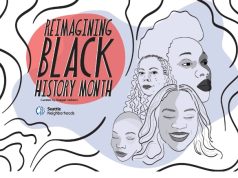Web-development firms tend to be either “nerdy” or “artsy fartsy.” That is, they focus either on the technical (programming, software development, etc.) or the creative (web design, presentation). But Saltmine LLC, Seattle’s biggest web-dev company, strives to do both, equally well. Heading its creative and design efforts is David (Davey) Jolosky. With 13 years under his belt in advertising and graphic design, five of those in Web and new media — not to mention plenty of accolades for his work — we were surprised when Davey referred to himself as “egoless.” Yet, that statement rings true if you consider Saltmine’s emphasis on transparently melding with its clients’ operations and putting its clients’ culture, image and visibility above all else. Here’s a look deep inside Saltmine’s creative center, whose efforts radiate from the heart of Westlake Center to offices worldwide.–LS
Seattle24x7: Do you believe in archetypal images and symbols for things like icons or navigational interfaces?
Jolosky: I believe navigation is critical to the success of a website. In fact, we just got the “Best Investment Site” award from the Web Marketing Association for our work on Russell.com (for Tacoma-based client Frank Russell Co.). One of the judge’s comments was that the visual navigation and the content “work hand in hand…the way it should be.” We believe in that, and we design for it.
Seattle24x7: What was the message you were communicating for that site?
Jolosky: Russell was targeting a specific audience but not engaging them. In our research, we determined that nobody was “ready” for Russell in that approach. We turned the problem into a challenge: “Are you ready for Russell?” That became the theme of the website, and we answered that challenge on the site through navigation and content, by asking users to: a) learn about investing; b) plan for those investments; c) implement that plan. Essentially, we gave them three avenues, three choices to make. It was simple. Looking back on it, it was kind of painfully simple.
Seattle24x7: The best creative, then, achieves a simplicity?
Jolosky: My personal philosophy comes from a quote by Charles Mingus. The idea is that creativity is making the complex awesomely simple. I completely believe in that. I don’t believe in things like Flash for Flash’s sake. I love entertainment sites, don’t get me wrong, that’s what they are – just entertainment sites. However, if what I want to do is learn something, I want a nice, simple, easy-to-use, visually-pleasing experience.
Seattle24x7: How is the creative department structured within the Saltmine?
Jolosky: I oversee all the creative teams in London, Chicago and Seattle. That’s about 35-plus people, and it includes art directors, graphic designers and multimedia people. Our writer teams are headed by a separate editorial director. And we also have a recording studio in our office, with some video capabilities as well. Production also falls under my realm.
Seattle24x7: Does usability fall under the creative department at Saltmine?
Jolosky: Usability is a creative group. Within the structure of Saltmine.com, they’re parallel disciplines. Creative has the sessions with usability to come up with good solutions. We’ll take a prototype from a usability expert and put some visuals on it.
Seattle24x7: Is there a design philosophy at Saltmine? Is there a particular developmental process you go through?
Jolosky: I think the philosophy here is to understand the client’s business and work for that business as opposed to making a creative statement like: “I feel that orange is the color of the millennium, and I’m going to spin my thoughts into that.” It doesn’t stop at taking an order from a client. We strive to think through the “what-if” scenarios creatively for them, to show them the way out of the box.
Our process here is very much rooted in traditional models of understanding the client’s criteria, meeting that criteria, but then asking that one question: “What if we took it one step further?” or “What if we attack the target audience from this angle?” Raising it to the next level, if you will. But we’re not going after bleeding-edge to go bleeding-edge.
We also strive to tell a story. By story, I mean visual story and visual storytelling. The Web is like any other visual medium from that standpoint. Say something. Make somebody do something. Make somebody cry, make somebody laugh. Make somebody buy. What’s unique is that the story is shaped by the user. I’ll equate this to technology. You can size the browser window, you can change the resolution, and you can connect with devices like a handheld PDA that crams this visual experience into a smaller space. The user controls the mechanism. The designer controls how it’s represented, and if you’re telling a great visual story, if you’re conveying something that has some common features, I think that can be interpreted for the user in any medium.
Seattle24x7: Do you hold usability focus groups and testing?
Jolosky: We have in-house facilitators that lead focus groups, do observational usability and identify users. We’ll actually track the user down to the level of where eyeballs are focusing if that’s something the client needs. Usability is probably the $9 zillion dollar buzzword for 2001 – understanding, identifying, creating and designing for the user. We’re living in a visual, tactile, oral, olifactory world, and you’ve got to understand those experiences as well.
Seattle24x7: What do you design for? Is there a minimum standard of compatibility for the Netscape or Explorer browser? Do you use browser detection?
Jolosky: We listen to our clients. We’ll ask them who are you trying to speak to? Who are you trying to get involved? If the client is interested in talking to everybody on the planet, then we’ll pick the lowest common denominator, a 3.0 browser that supports forms and is capable of supporting plug-ins.
We don’t typically rely on a lot of high-end HTML technology or the browser experience to take over. Sometimes we’ll identify a need for it, like when the client wants to use something like a drop-down navigation system. But we’ll advise the client whom they may be losing if we go that route. And you have to look at that opportunity cost.
A lot of clients, for instance, are asking for Flash, but they don’t want to alienate those not willing to get the plug-in. So we’ll use [browser] detection to tell the user “we’re detecting you at a lower bandwidth, and we’re going to send you this way,” or “we’re detecting that you don’t have Flash and we suggest that you get the plug-in or we’re going to point you to an alternative route.”
Seattle24x7: What’s the most exotic thing you’ve ever done?
Jolosky: We got pretty “out there” with Wizards of the Coast [Renton, Wash.-based game company, now owned by Hasbro]. We produced a CD-ROM version of Magic: The Gathering [a card game]. Did the entire catalogue of over 7,000 cards in a CD-Rom database, including animation and sound. We gave the user the ability to pull down new cards, make, create, save and share decks. We had Macromedia Director talking to ASP (Active Server Pages) talking to a database. We created custom Active-X controls that were essentially custom Director Xtras. They were doing things like driving Quicktime, driving database calls, driving information, and all packed up neatly on a CD-ROM. It was an online experience, an offline experience, and it equated to a print experience, which was the actual physical embodiment of the card itself.
Seattle24x7: Are you creating these CD-ROMs to connect to the Web?
Jolosky: The CD is a foot in the door. It’s something physical people have become familiar with. Jane or Joe average consumer knows how to use a CD, whereas the Web is still confusing to the average consumer. They know how to use it, they begin to understand it, but when something breaks, they don’t know why. If we can embody a Website, or a component of the Web on the CD, half the battle is done.
Seattle24x7: Before you joined Saltmine, you worked with FreeRange Media, among other agencies. You also got a chance to work with the legendary Scott Adams, the creator of the Dilbert cartoons. What was it like working with him?
Jolosky: The project was called the “High-Tech Adventures of Young Dilbert.” Scott Adams wanted to create a young version of Dilbert — the adventures of fixing a computer and learning about computers and playing computer games — for a younger audience, ages 5 to 9. Working with United Media was great. I designed an original character for Scott, a little computer virus. It was fun working in his style. My influences in the genre are things like The Far Side [created by Gary Larsen] and Matt Groenig [creator of The Simpsons], who are both, by the way, from the Pacific Northwest.
Larry Sivitz is managing editor at Seattle24x7.com
=========================================
Saltmine LLC
http://www.saltmine.com
Seattle office
413 Pine Street
Third Floor
Seattle, WA 98101
Phone: 206.284.7511
Fax: 206.284.7875
On-Site Technical Services
10900 NE 8th Street
Suite 230
Bellevue, WA 98004
Ph: 425.956.1800
Fx: 425.450.0323
Year founded: 1995
Number of employees: 450
Amount of VC funding: $5M+ to MPL2 in 1995
Major clients: BP Amoco, Microsoft, AT&T, Frank Russell Company, PGA Tour, Muzak, Nordstrom, Puget Sound Energy, Washington Mutual, Wizards of the Coast




















